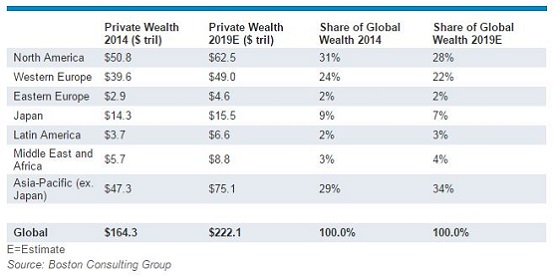Three wealth trends to watch
Summary: Most wealth management clients want more digital interaction with their financial advisors, meaning advisors need to up their game as technology-driven upstarts gain assets fast. Meanwhile, Asia continues to grow in wealth, while more than 2 million new millionaires were created globally in 2014. |
Key take-out: Most wealth managers are looking for ways to couple easy-to-use technology platforms to their more sophisticated offerings. |
Key beneficiaries: General investors. Category: Strategy. |
Private wealth globally grew by 12 per cent last year, touching $US164 trillion, claims Boston Consulting Group. In that torrid growth, says the firm, there are three trends in particular worth watching: Robo advisors starting to shake up the traditional financial advisor model; the rise of the Asian billionaire; and the expectation that the world's wealthiest will continue to get rich faster than everyone else.

Robo advisors
In an age of smartphones and tablets, private bankers aren't getting it, claims BCG. According to their study, about 75 per cent of wealth management clients are demanding more digital interaction with their financial advisors, while only 25 per cent of wealth managers offer “customised advice online.” To remain relevant to next-generation heirs, financial advisors need to up their game, says BCG senior partner Brent Beardsley.
That's because technology-driven upstarts like Wealthfront and Betterment are sucking up assets fast. These so-called robo advisors are already managing billions of dollars for clients, and clients' costs are minimal, since an investor's asset allocations and rebalancing are executed automatically using software. These robo advisors charge about 0.30 per cent for these services, so clients can save 1.00 per cent by cutting out their wealth manager. No face-to-face interaction is necessary.
But it's mostly a struggle for mass affluent assets, not the truly rich. BCG's Beardsley expects robo advisors to steal assets from the low-hanging fruit: The modestly wealthy with savings below $US250,000. Brokerage firms that cater to the same clientele are struggling to keep the financial advisor model relevant, he says, when up against this low-cost and automated model. Meanwhile, private bankers and top-tier multi-family offices who handle the wealthiest Americans will be more insulated, since advisors deal with more complicated trust and estate planning issues. BCG's conclusion jibes with what Barron's concluded in its recent cover story, “Robo Advisors Take On Wall Street”.
But that doesn't mean the wealth advisory firms at the top of the pyramid are sitting on their hands, where there are still signs that wealthy clients are starved for digital products. Beardsley reports that most wealth managers have started talking with robo-advisory firms, looking for ways to couple easy-to-use technology platforms to their more sophisticated offerings.
Rise of Asia
In 2014, North America was still the wealthiest region in the world, with $US50.8 trillion in private wealth and a modest 5.6 per cent increase. But Asia continues to close the gap. Asia-Pacific (ex-Japan) grew by a whopping 29.4 per cent, vaulting to $US47.3 trillion. BCG predicts that by either later this year or early next year — depending on Asia's rollercoaster equity market — the region will surpass North America as the wealthiest corner of the globe. BCG also estimates that between 2014 and 2019, Asia will account for half of the $US57.8 trillion in new wealth created globally. BCG is sticking to its prediction that China will overtake the US as the wealthiest nation in the world by the end of the decade. See the table below for more on the changing composition of wealth globally.

Mass-minting millionaires
There were 2.1 million new millionaires created globally in 2014, BCG says, pushing the aggregate up to 17.4 million households. To put that in perspective, millionaires made up 1 per cent of households worldwide but accounted for a staggering 42 per cent of the globe's overall wealth.
In Penta's “Anatomy of a Billionaire,” a UBS survey of billionaires throughout the globe suggested we're entering a Second Gilded Age of money creation and philanthropy. BCG's survey lends further credence to those predictions. Between 2014 and 2019, it says, the $US100 million-plus wealth segment will be the fastest growing, increasing 8.8 per cent annually, versus 2.4 per cent for the slowest growing sub-$1 million category.
All that data is grist for the political mill, as Republican and Democratic hopefuls discuss what it all means while they jockey for the presidential nomination of their parties.
This article has been reproduced with permission from Barron's.













